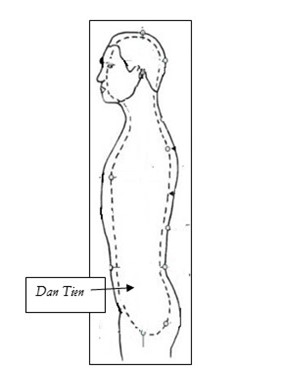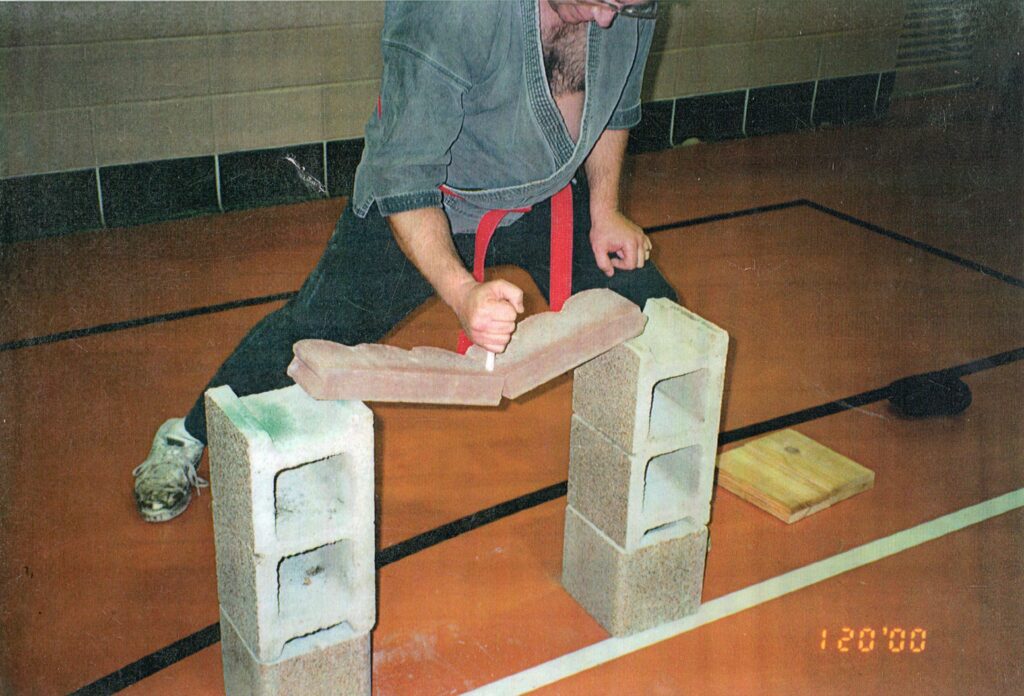
If you’ve ever been to a karate tournament, you are sure to see breaking competition. Breaking is the time for testing your power and concentration. The stakes a high. Hundreds of people are watching. If you screw up, not only will you hurt yourself, but you will be embarrassed. You have been working for this moment for years, starting off with training to break as a yellow belt.
A 12×12-inch piece of wood is nothing to what you are setting out to accomplish today. You have great confidence that your break will succeed. You have visualized it for days. You practiced in the dojo, gradually working your way up to the more difficult breaks.
Breaking is not for the faint of heart. At one tournament, a “master” wanted to break a 3 x 3 x 4-foot slab of ice with his head. The trick to this is to cut slices in the ice every six inches or so, so it loosens up the ice. His ran into a problem, though, he nearly broke his head instead. In 100+ degree August weather, after sitting in a gym most of the day, the ice melted and froze the cuts in the ice. It was as solid as a rock. No way anyone could have broken that. The lesson here is to carefully chose your breaking medium, and if you want to break ice, perhaps wintertime would be a better time to do it!
“tameshiwari”
The word “tameshiwari” comes from Japanese, where “tameshi” means “test” or “trial,” and “wari” means “break” or “split.” Together, it roughly translates to “test of breaking.”
The Japanese, in their efficiency, use the word interchangeably with occupations other than breaking wood. But they are all used to “test.” In business and marketing, they test the product; culinary arts – taste the food; education – assess how the students are progressing; product development – testing their cars, as an example, which are some of the best on the market.
There are different uses of the word, but in the end, the meaning of tamashewari for our purposes, is to test your strength, your concentration and focus, your training.
Breaking is not the goal of the martial arts, simply another aspect. Like kata and kumite, tamashewari has its place. It gives the practitioner a chance to test their skills in a noncombative environment – your only opponent is the medium you are breaking. Will you break it, or will it break you?
I can tell you from experience, if you miss, it hurts – missing may lead to broken bones. To avoid that, you must train.
Makiwara
In his book “Okinawan Karate: Teachers, Styles, and sacred techniques” (1999), Mark Bishop tells of his interview with Seiki Arakaki, student of Hohan Sokan, of the Matsumuru Orthodox Shorin-ryu style. When asked about makawara training, Arakaki Sensei had this to say:
“A makawara should be springy with a generous amount of give, or the constant striking of it will damage the striker’s wrists. There were, and still are, basically two types of makiwara, the flat board and the round post. The flat one is used for practicing the straight corkscrew punch and the round one, which has one or two splits halfway down the middle, is used for training the fist, elbow and the side of the hand. Makiwaras should always be padded with something soft like straw-rope, rubber or carpet, to cushion the impacts of the strike.”
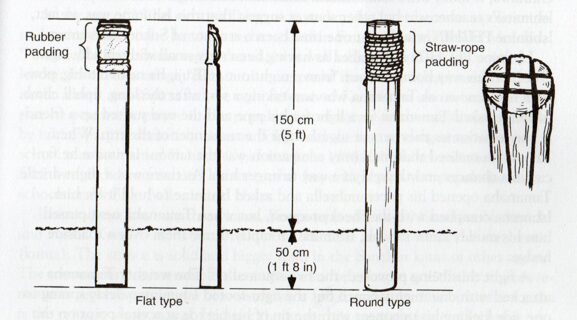
Later, Arikaki developed a large flat makiwara originally meant for children to use. It was softly padded with rubber, and gave easily, which prevented injury. This type of makiwara is also useful for practicing side and jump kicks.
Arikaki’s father warned him about getting huge black callouses on his knuckles from using the makiwara. His father was a merchant, and feared that his customers, on seeing such swollen and deformed hands, would be frightened and turn away. Plus, the local ruffians loved to pick out the so-called karateka that used such techniques to show off their prowess. “After practicing on the markiwara it is a good idea to wash one’s hands in salt water (or urine) and then alcohol. If the skin is cut, always carefully sterilize the affected area.”
“When first using the makiwara, one should punch softly and then gradually increase the power day-by-day.”
A can of sand
Take a one-pound coffee can and fill it with sand. Set it on the counter, preferably waist-high so you don’t have to bend over and move the can with your punch. The can should be heavy enough so that it will not slide on its own, and you will have to put some force behind it. This is a good place to practice your one-inch punch, popping the fist forward with a flick of the wrist.
Sand is also useful for conditioning your fingers. Practice doing spear fingers into the sand; this will toughen them up nicely.
Be sure to take good care of your hands, though, because you don’t want to end up like this….

Snuff the candle
This is a fun way to practice your focus. Light a candle and try to put it out with a punch or a hand strike without touching the flame. Sounds easy.
Hand care
If you want to break, you have to toughen the hands. There is a way to keep from having makiwara hands, and although using the makiwara is only one way to train, you also must strengthen your hands just for general self-defense purposes. How can you punch someone in the jaw if your hands are soft?
These are measures all martial artists should use to protect and toughen their hands. In traditional Okinawan training, there are toughening exercises for all parts of the body – 1) to increase the tolerance for pain, 2) to make the muscles stronger so you can better withstand an assault.
I don’t think it is entirely possible to not end up with damaged hands, if you want to be a champion at tameshiwari. In later life, arthritis will inevitably step in. But that’s later in life, right? In the meantime, here are some hand care tips.
- Dit daw jao is a wonderful liniment that takes the soreness away and has amazing healing powers. You can make your own concoction by adding other chinese medicines to the mix, such as iron palm strengthening, and mucle and tendon mixes.
- Epsom salts. If you don’t have cuts or scratches, epsom salts in warm water works well in taking the swelling and pain down.
- Back off training if injury occurs. Give your hands a chance to heal before going back at it.
- Circuit train. Makiwara, sand training, practice breaking, rest. Every four days, you start the circuit over again.
If you train well, and slowly progress, you will save your hands and enjoy the wonders of breaking.
Bricks on fire!
This is not something you should try on your students, but martial artists are crazy people, right? Always testing limits, seeing just exactly what the art has to offer as far as prowess and difficulty. The pictures here is of Pickett when he was 16 years old, giving a demonstration. Too bad there isn’t a video of this, it would be something to see, but you’ll have to use your imagination. Is this something you would try?
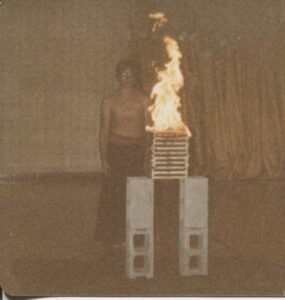
Breaking techniques (tamishiwari)
This is a page from the Mushin Dojo black belt book on breaking.
A. Purpose:
It is stated that boards and bricks will not attack you. The reason one needs to know about breaking is to channel your inner powers that are used for general purposes, e.g. body cleansing, sex, and all physical activities that take on mental concentration. By understanding “in-focus” concepts we can now go about generating and controlling these powers that all humans have and magnify it to excel into activities that are physical.
B. Focusing – Methods used:
- Clearing the mind into void.
- Pinpointing a focal area.
- To foresee the break, through in-focus prep (mental rehearsal).
- To be able to divorce all outside activities from the mind until one senses harmony and ease.
C. Hand conditioning:
- Start with a sandbag and work up to a makiwara.
- Experiment by applying one or a combination or focusing methods.
- Focus on your lower diaphragm with each hit by intensifying your stomach (by bloating it out).
- Use proper hand liniments after and heating of the hands to keep them from becoming arthritic or cancerous, such as Dit-Da-Jow.
D. Three methods of breaking:
- Brute force
- Ki or chi
- Depressurizing. The feeling of depressurizing (like squeezing your nose and blowing air to clear your ears), thus cutting the stimulus of pain to the brain allowing continuous follow through.
In-focus picture of the mind (mental rehearsal or preparation of the mind)
Purpose:
To Improve confidence, reaction time and physical coordination. Also, increases concentration and gives greater control over every aspect of your art. During mental rehearsal a state of relaxation erases thoughts and feelings from your mind and focuses on a blank screen on which you can project the moving images that directs your athletic abilities. You prepare your mind (inner) to coincide with the athletic event or art (outer) which in turn primes you towards your focal performance.
These mental rehearsals must include movements rather than static postures. Here’s where you create chances to complete each action, whereas the mental imaginary action will respond automatically to your physical self. In order to develop mental rehearsal, one might at start go merely into impressions. Don’t overreach. Make sure that the performance level (mentally) you are trying to attain is well within the realm of possibility.
In summation, the aim of the martial artist is to be able to maximize into a high responsive stage and to ensure that the (inner) and (outer) self-matures equally.
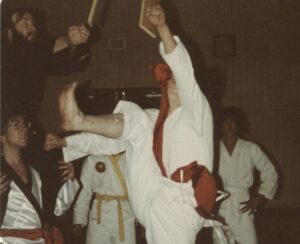
Breaking competition
Some people like to break for seminars and demonstrations. Others like to try their skills in tournament breaking competitions. If you break in a tournament, there are some politics involved, such as searching out the judges and determining their preferences. Some judges like flash, but most appreciate pure, solid technique. The competitors usually set up their boards and bricks beforehand, and this gives you a chance to scope out the competition. But in the end, it doesn’t matter what the judges think, or what the competition looks like, in the end, it’s just you and your break.
Now is not the time to be nervous and lose your focus. That is the point of this, right? To test your focus and concentration under the most stressful conditions? Breaking in a tournament is like public speaking; lots of fear and anxiety, getting in front of an audience and showing your stuff.
Be sure to keep your breaks within your possibilities. This is not the time to try something new. And for sure, try not to be a hero and break something like a slab of ice in the middle of summer!
As one judge once told me, “You have to believe in yourself.” Perhaps, ultimately, tameshiwari is the test of the spirit.
Here are a couple of articles on breaking you might like.
MasutatsuOyama.com – Tameshiwari – The art of breaking
The Quick & Dirty Guide to Tameshiwari: Breaking Stuff the Karate Way (karatebyjesse.com)
Happy breaking!
Sensei Carol


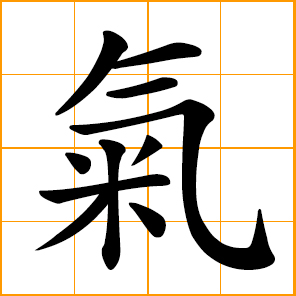 There is a remarkable power within each of us, but few are aware of how powerful we really are. This is our life force, and it is known simply as Qi. In this article, we will explore an amazing way to unleash this power.
There is a remarkable power within each of us, but few are aware of how powerful we really are. This is our life force, and it is known simply as Qi. In this article, we will explore an amazing way to unleash this power.